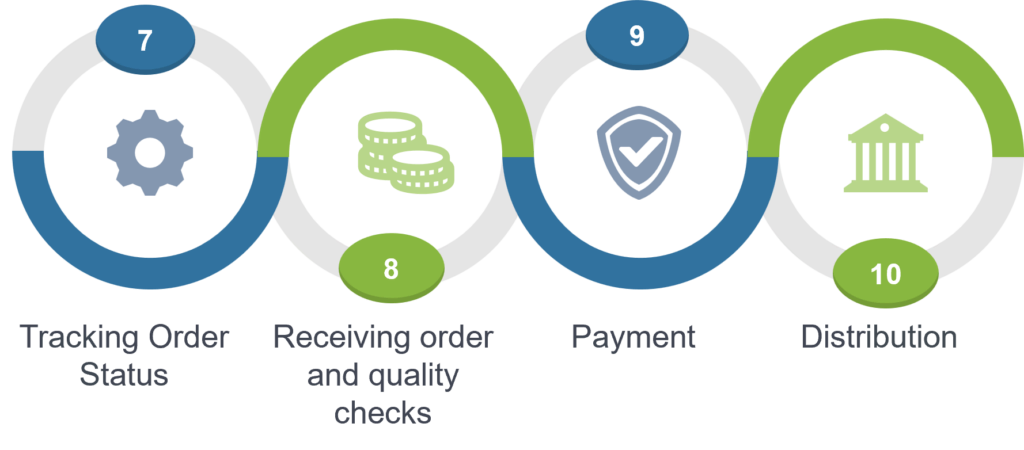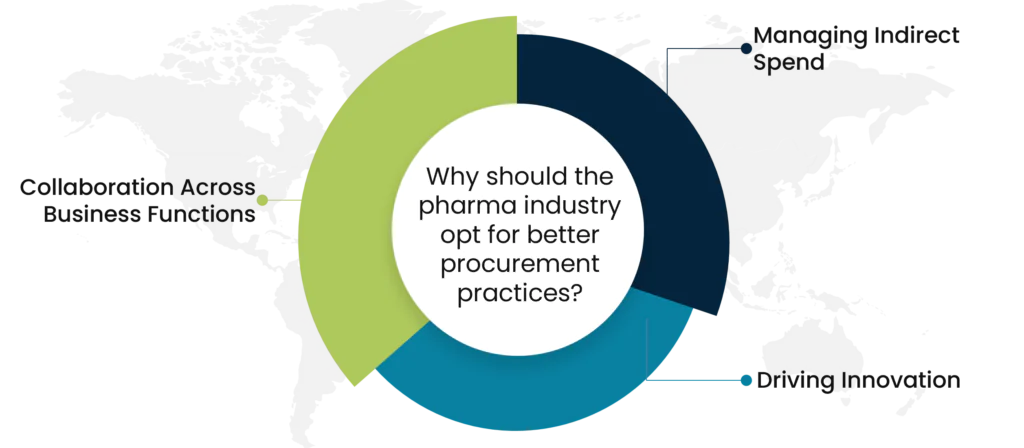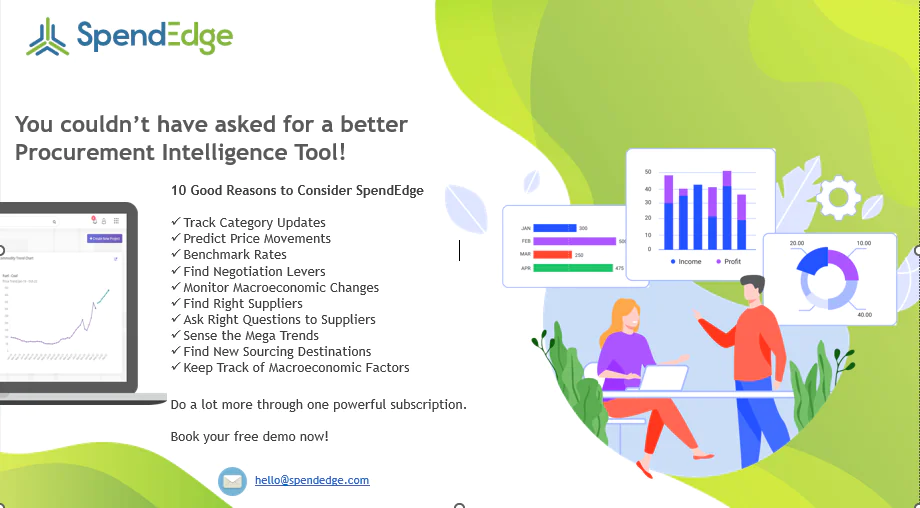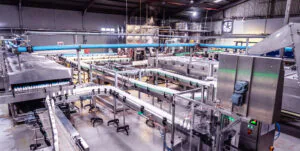Table of the content
- Introduction to the industry
- Understanding the procurement process in pharma
- Why should the pharma industry opt for better procurement practices?
- Conclusion
Introduction to the industry
Today, we can see an increasing trend amongst top companies opting for better procurement management to save costs and remain competitive in the marketplace. Procurement is more than just a cost-cutting tool. By reducing waste and optimizing resources, pharma companies can significantly boost their efficiency. The pharma industry has to tackle a lot of modern-day challenges right from generic drugs, personalized medicines, and rising research and development costs to expensive clinical trials. Improvement of the procurement process in the pharma industry can solve such problems and improve the industry’s profitability.
Understanding the procurement process in pharma
Here is an explanation of each step involved in the process:


Step 1. Drug selection review
This step involves evaluating the therapeutic needs and selecting the appropriate medicines to procure. It requires clinical and technical assessments to ensure that the selected drugs meet quality standards and are suitable for the intended treatments.
Step 2. Identifying the quantity needed
Accurate determination of drug quantities is crucial to meet patient demand without overstocking. This involves analyzing historical consumption data, forecasting future needs, and considering factors such as seasonal variations and disease prevalence.
Step 3. Aligning needs with the budget
Balancing the procurement needs with the available budget requires careful financial planning. It involves prioritizing essential medicines, optimizing resource allocation, and ensuring that procurement decisions align with the financial constraints and strategic goals of the organization.
Step 4. Choosing an appropriate procurement method
Choosing the appropriate procurement method is vital for efficiency and compliance. Methods may include direct purchasing, competitive bidding procedures, and e-procurement. The choice depends on factors such as cost, urgency, regulatory requirements, and market conditions.
Step 5. Selecting suppliers
Selecting reliable suppliers is critical for ensuring the quality and timely delivery of medicines. This step involves evaluating potential suppliers based on their financial stability, compliance records, operational capabilities, and past performance. Strong supplier relationships are essential for a resilient supply chain.
Step 6. Framing contract terms
Clear and comprehensive contract terms help avoid misunderstandings and disputes. Contracts should detail the specifications of the medicines, delivery schedules, payment terms, compliance with regulatory standards, and other relevant conditions to ensure both parties’ obligations are well-defined.
Step 7. Tracking Order Status
Continuous monitoring of the order status ensures timely delivery and helps identify any issues that might arise. This involves maintaining communication with suppliers, using procurement software for real-time tracking, and being prepared to take corrective actions if delays or problems occur.
Step 8. Receiving order and quality checks
Upon delivery, the received drugs must be thoroughly inspected to ensure they meet the specified quality standards and compliance requirements. This includes checking for correct quantities, expiration dates, proper packaging, and any signs of damage or tampering.
Step 9. Payment
Timely and accurate payment for the orders is necessary to maintain good supplier relationships. This step involves verifying invoices, ensuring they match the purchase orders and delivery receipts, and processing payments according to the agreed terms.
Step 10. Distribution
Efficient distribution of medicines to pharmacies and other dispensing points ensures that drugs are available where needed. This involves managing logistics, inventory control, and ensuring that drugs are distributed in a timely manner to meet patient demand.
Why should the pharma industry opt for better procurement practices?

1. Driving Innovation
In pharmaceutical procurement, innovation extends beyond drug development alone. Exploring innovative approaches to procurement and sourcing processes holds the potential for pharma companies to unlock significant savings opportunities. For instance, leading pharma companies can pioneer inventive incentive models to encourage suppliers to propose novel ideas for accessing new markets through innovative sales channels. By prioritizing spend control and fostering collaboration across divisions and functions within both the supplier network and internal stakeholders, companies can cultivate an environment ripe for innovation.
Embracing comprehensive procurement processes and leveraging diverse procurement methods, such as direct procurement and utilizing e-procurement platforms, empowers pharma organizations to optimize their procurement strategies. Establishing a robust procurement organization and fostering a culture of procurement excellence are vital components in driving innovation within the industry. Building a skilled procurement workforce equipped to explore new avenues and capitalize on emerging opportunities is essential.
Implementing procurement incentives that reward creativity and initiative can fuel innovation within the organization and incentivize suppliers to contribute valuable insights. Cultivating a culture of procurement collaboration ensures that ideas are shared, evaluated, and implemented effectively. Developing a flexible procurement structure with clearly defined procurement roles and responsibilities fosters agility and adaptability in responding to market dynamics and driving innovation forward.
2. Collaboration Across Business Functions
When it comes to procurement strategy, collaboration across business functions plays a pivotal role in optimizing operations and driving success. When it comes to outsourcing critical processes like conducting clinical trials, business managers often seek a capable strategic partner. However, there’s a reluctance to entrust such decisions solely to the procurement team.
Nevertheless, it has become increasingly evident that when the procurement function assumes responsibility for executing such activities, they excel in identifying the best partners and negotiating terms that enhance overall performance and output. Clear delineation of procurement roles and responsibilities is essential to ensure a seamless flow of operations and maximize outcomes.
Incorporating advanced procurement systems, including procurement ERP systems and procurement digital analytics, empowers organizations to leverage procurement data effectively and identify valuable procurement opportunities. Seamless procurement interfaces facilitate collaboration between different business functions, enabling cross-functional teams to capitalize on procurement investments and enhance procurement capabilities.
Embracing procurement imperatives ensures alignment with organizational goals and fosters a culture of innovation and continuous improvement. Investing in procurement talent and cultivating a skilled workforce equipped with the necessary expertise and capabilities is crucial for driving success in procurement endeavors. By prioritizing collaboration and integration across business functions, organizations can unlock new avenues for growth and drive sustainable success in procurement initiatives.
3. Managing Indirect Spend
In pharmaceutical procurement, managing indirect spend constitutes a significant portion of overall expenditures. A substantial majority of spend within a typical pharma company is allocated to indirect spend categories, encompassing areas such as IT, MRO, office supplies, travel, logistics, and marketing. These categories collectively represent millions of dollars in expenditure, highlighting the immense potential for cost savings through enhanced procurement processes.
Improving procurement processes within the pharma industry entails implementing stringent policies, leveraging proper tools, and providing comprehensive spend visibility. By doing so, companies can optimize savings derived from indirect spends while ensuring compliance with regulatory standards.
Central to this endeavor is the assurance of drug availability, ensuring that the right pharmaceutical products are sourced in the right quantity and delivered in a timely manner. Adherence to approved quality standards is paramount, fostering supplier relationships founded on trust and transparency. All procurement activities must be conducted in an ethical manner, prioritizing integrity and compliance at every step.
Moreover, optimizing purchase prices requires the involvement of competent personnel possessing pharmaceutical expertise, managerial expertise, legal expertise, and financial expertise. These multidisciplinary teams collaborate to navigate the complexities of procurement while mitigating risks and maximizing value.
Integration of robust technology further enhances procurement efficiency, enabling automation, data-driven decision-making, and streamlined processes. Through the strategic utilization of technology, pharma companies can drive cost savings, improve operational agility, and maintain competitive advantage in a dynamic marketplace.
For more information on procurement in the pharma industry, pharma procurement, procurement process in the pharma industry, and indirect spends:

Conclusion
Effective pharmaceutical procurement is essential for driving innovation, optimizing operations, and maximizing cost savings in the pharma industry. By embracing a comprehensive procurement process and leveraging diverse procurement methods such as direct procurement and e-procurement platforms, organizations can enhance their procurement capabilities and foster a culture of procurement excellence. A well-defined procurement organization with clear procurement roles and responsibilities is crucial for ensuring seamless operations and driving successful procurement initiatives. Implementing procurement incentives and fostering procurement collaboration across business functions enables organizations to unlock new opportunities and drive innovation. Furthermore, integrating advanced procurement systems such as procurement ERP systems and procurement digital analytics empowers organizations to harness procurement data effectively and identify valuable procurement opportunities. By investing in procurement talent and prioritizing procurement investments, organizations can build a skilled procurement workforce capable of driving sustainable success. Overall, prioritizing procurement strategy and embracing procurement imperatives are essential for organizations to stay competitive and achieve long-term success in the dynamic pharmaceutical industry landscape.




